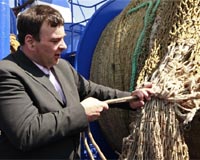Sharks are prized for their meat, and in Asia especially for their fins, a prestige food thought to convey health benefits.
The most comprehensive survey of 64 shark species of open water, or pelagic zone is published days before an international meeting on high-seas tuna fisheries.
Why is this meeting important for shark conservation?
1. For decades, significant numbers of blue and mako sharks have perished as “by-catch” in commercial tuna and swordfish operations.
2. Recently, the soaring value of shark meat has prompted many tuna fisheries to target sharks as a lucrative sideline, said Sonja Forham, Policy Director for the Shark Alliance, and co-author of the study.
3. *The Spanish fleet of surface longline fishing boats supposedly targets swordfish, but 70 percent of its catch, by weight, fcomes rom 2000 to 2004 were pelagic sharks.
Unprotected sharks will perish to human greed
With no restrictions on the number of sharks that these fisheries can harvest and despite mounting threats, sharks remain virtually unprotected on the high seas.
Click here to help save the sharks.
The great white shark, Carcharodon carcharias, also known as great white, white pointer, white shark, or white death, is an exceptionally large lamniform shark found in coastal surface waters in all major oceans. Reaching lengths of more than 6 metres (20 ft) and weighing up to 2,240 kilograms (4,938 lb), the great white shark is arguably the world’s largest known predatory fish. It is the only surviving species of its genus, Carcharodon.
The hammerhead sharks belong to the family Sphyrnidae, the hammer sharp of their heads, which are flattened and laterally extended into a “hammer” shape called a “cephalofoil”. The cephalofoil, probably contains sensory reception, maneuvering, and prey manipulation ability. The nine known species of hammerhead range from 0.9 to 6 m long (3 to 20 feet). All the species have a projection on each side of the head that gives it a resemblance to a flattened hammer. The shark’s eyes and nostrils are at the tips of the extensions. Hammerheads are found worldwide in warmer waters along coastlines and continental shelves. Hammerheads are notably one of the few creatures in the animal kingdom to acquire a tan from prolonged exposure to sunlight, a feature shared by pigs and humans. Tanning occurs when a hammerhead is in shallow waters or close to the surface for long periods.
Click here to help save the sharks.
Resources
Excerpts courtesy of Terradaily.com/reports/Third_of_open_ocean_sharks_face_extinction_study
Excerpts courtesy of En.wikipedia.org
Image 1. courtesy of Myanimalblog.files.wordpress.com/2008/02/great-white-shark-picture-01.jpg
Image 2. courtesy of Images.google.com/wikimedia.org/wikipedia/commons/Hammerhead_shark.














You must be logged in to post a comment.